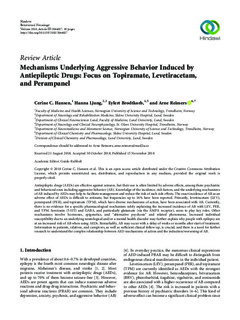Mechanisms underlying aggressive behavior induced by antiepileptic drugs: Focus on topiramate, levetiracetam, and perampanel
| dc.contributor.author | Hansen, Cerine Corin | |
| dc.contributor.author | Ljung, Hanna | |
| dc.contributor.author | Brodtkorb, Eylert | |
| dc.contributor.author | Reimers, Arne | |
| dc.date.accessioned | 2019-05-03T06:26:34Z | |
| dc.date.available | 2019-05-03T06:26:34Z | |
| dc.date.created | 2019-02-22T11:11:51Z | |
| dc.date.issued | 2018 | |
| dc.identifier.citation | Behavioural Neurology. 2018, 2018:2064027 1-18. | nb_NO |
| dc.identifier.issn | 0953-4180 | |
| dc.identifier.uri | http://hdl.handle.net/11250/2596378 | |
| dc.description.abstract | Antiepileptic drugs (AEDs) are effective against seizures, but their use is often limited by adverse effects, among them psychiatric and behavioral ones including aggressive behavior (AB). Knowledge of the incidence, risk factors, and the underlying mechanisms of AB induced by AEDs may help to facilitate management and reduce the risk of such side effects. The exact incidence of AB as an adverse effect of AEDs is difficult to estimate, but frequencies up to 16% have been reported. Primarily, levetiracetam (LEV), perampanel (PER), and topiramate (TPM), which have diverse mechanisms of action, have been associated with AB. Currently, there is no evidence for a specific pharmacological mechanism solely explaining the increased incidence of AB with LEV, PER, and TPM. Serotonin (5-HT) and GABA, and particularly glutamate (via the AMPA receptor), seem to play key roles. Other mechanisms involve hormones, epigenetics, and “alternative psychosis” and related phenomena. Increased individual susceptibility due to an underlying neurological and/or a mental health disorder may further explain why people with epilepsy are at an increased risk of AB when using AEDs. Remarkably, AB may occur with a delay of weeks or months after start of treatment. Information to patients, relatives, and caregivers, as well as sufficient clinical follow-up, is crucial, and there is a need for further research to understand the complex relationship between AED mechanisms of action and the induction/worsening of AB. | nb_NO |
| dc.language.iso | eng | nb_NO |
| dc.publisher | Hindawi | nb_NO |
| dc.rights | Navngivelse 4.0 Internasjonal | * |
| dc.rights.uri | http://creativecommons.org/licenses/by/4.0/deed.no | * |
| dc.title | Mechanisms underlying aggressive behavior induced by antiepileptic drugs: Focus on topiramate, levetiracetam, and perampanel | nb_NO |
| dc.type | Journal article | nb_NO |
| dc.type | Peer reviewed | nb_NO |
| dc.description.version | publishedVersion | nb_NO |
| dc.source.pagenumber | 1-18 | nb_NO |
| dc.source.volume | 2018:2064027 | nb_NO |
| dc.source.journal | Behavioural Neurology | nb_NO |
| dc.identifier.doi | 10.1155/2018/2064027 | |
| dc.identifier.cristin | 1679815 | |
| dc.description.localcode | Copyright © 2018 Cerine C. Hansen et al. This is an open access article distributed under the Creative Commons Attribution License, which permits unrestricted use, distribution, and reproduction in any medium, provided the original work is properly cited. | nb_NO |
| cristin.unitcode | 194,65,30,0 | |
| cristin.unitname | Institutt for nevromedisin og bevegelsesvitenskap | |
| cristin.ispublished | true | |
| cristin.fulltext | original | |
| cristin.qualitycode | 1 |

